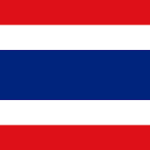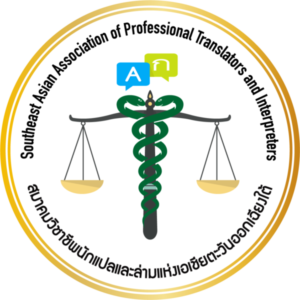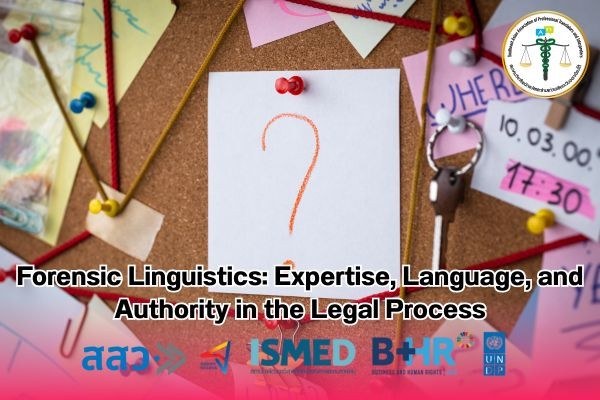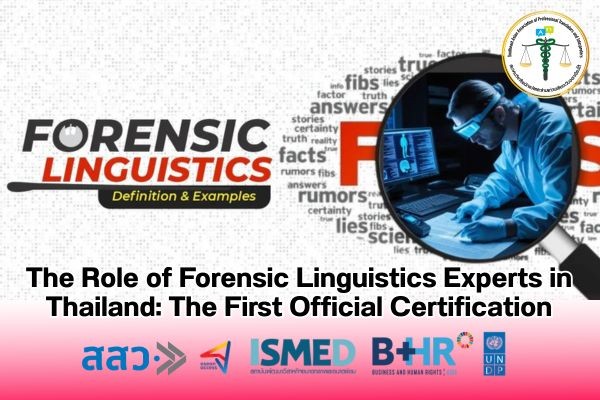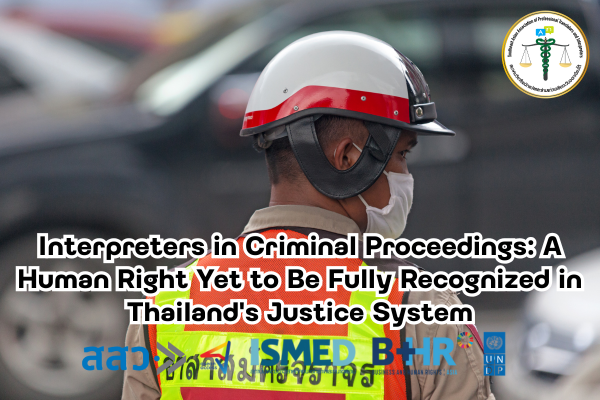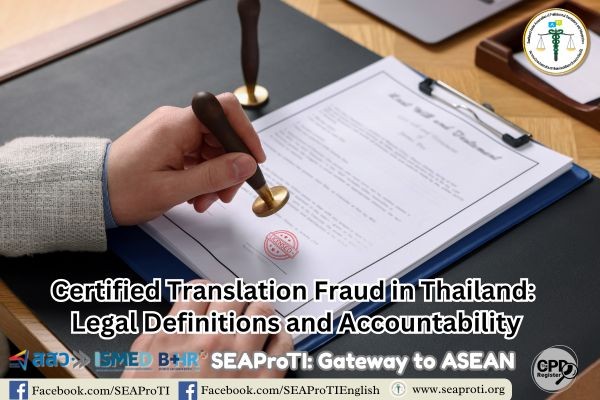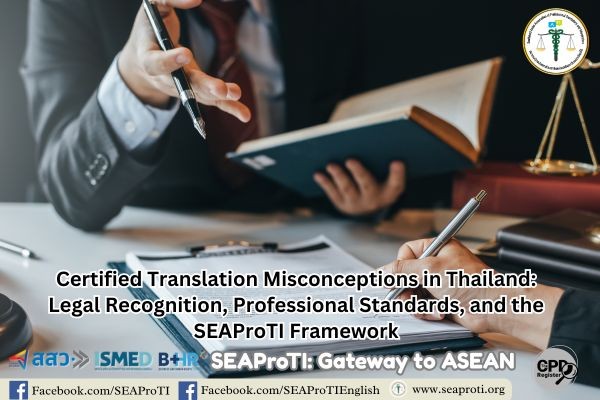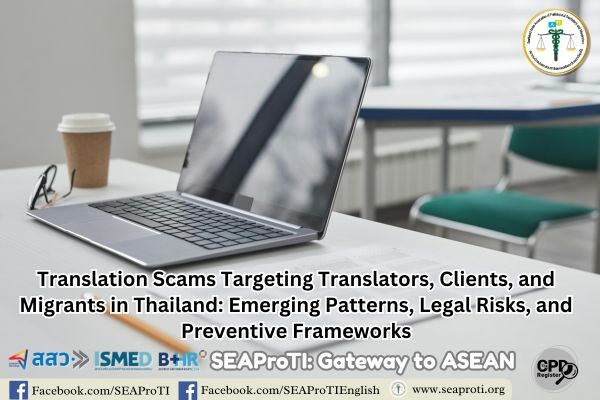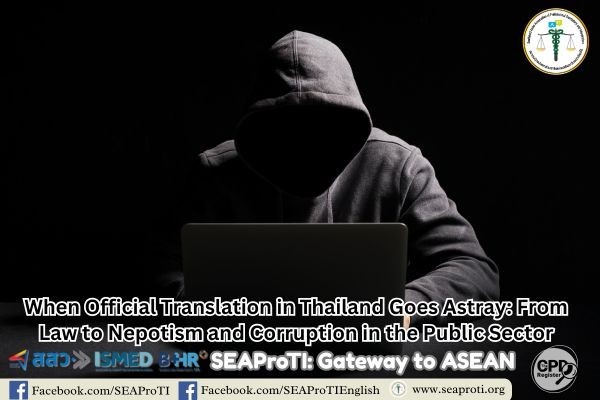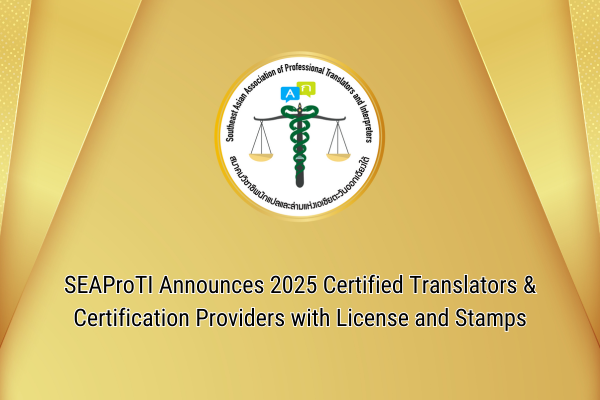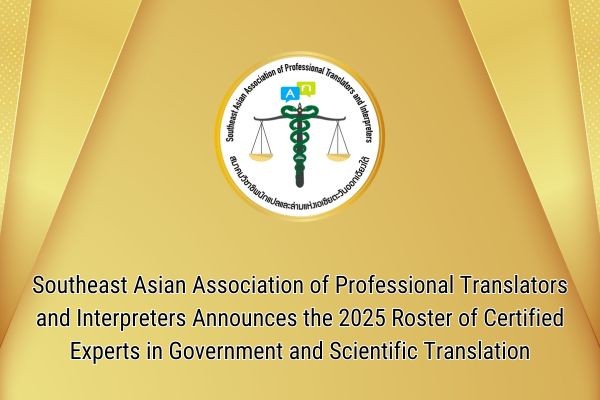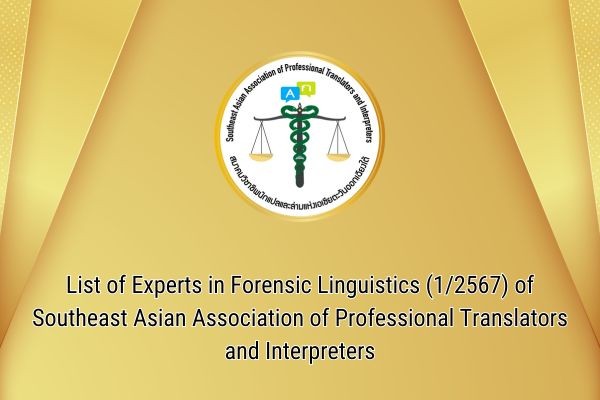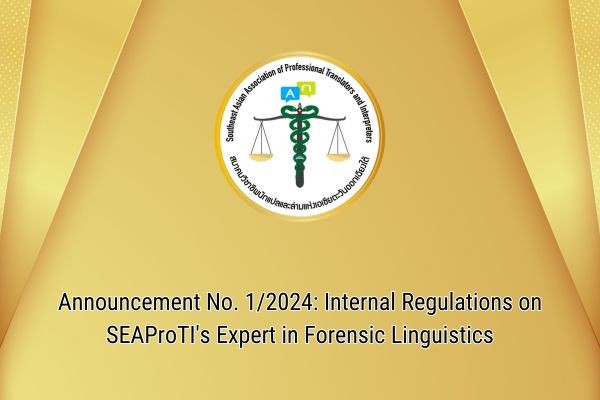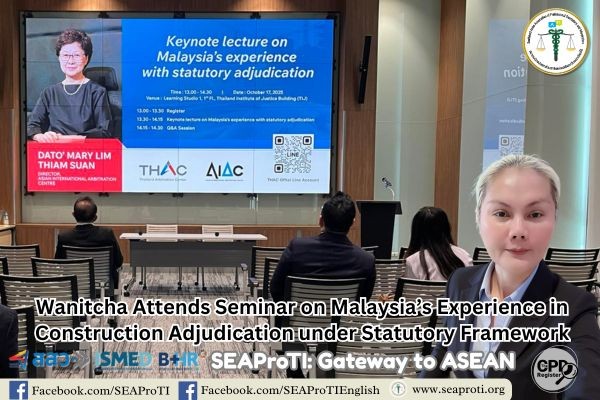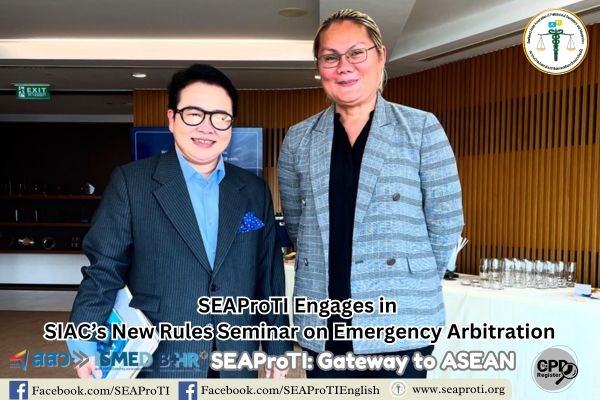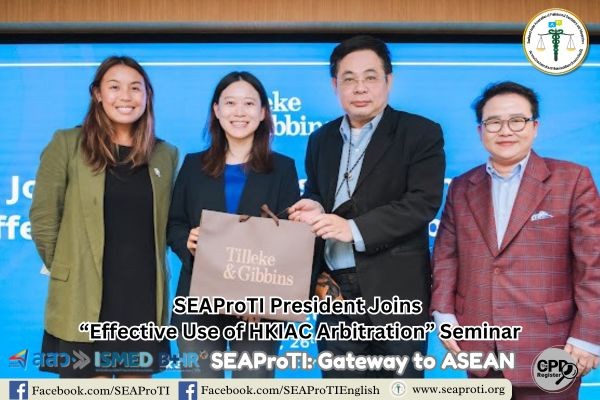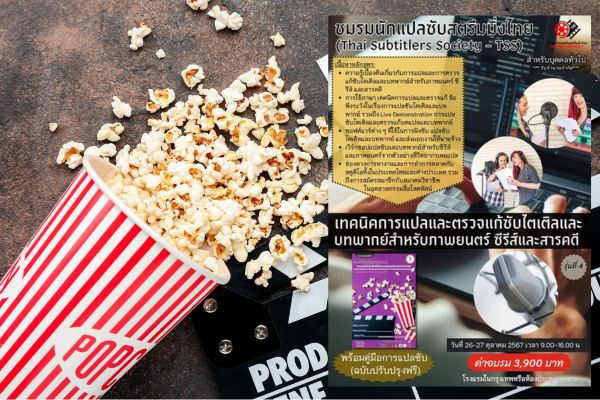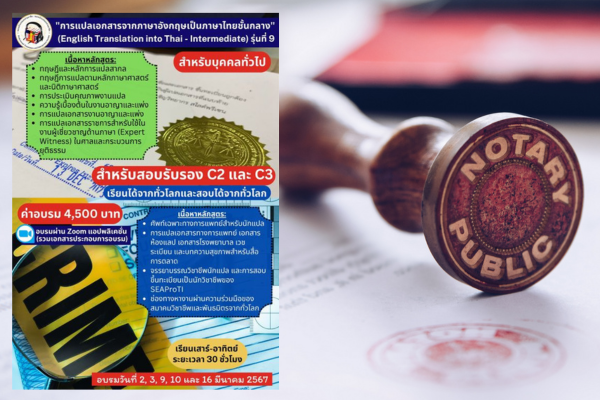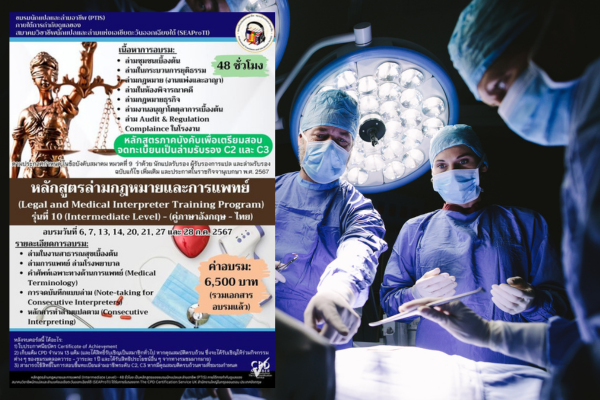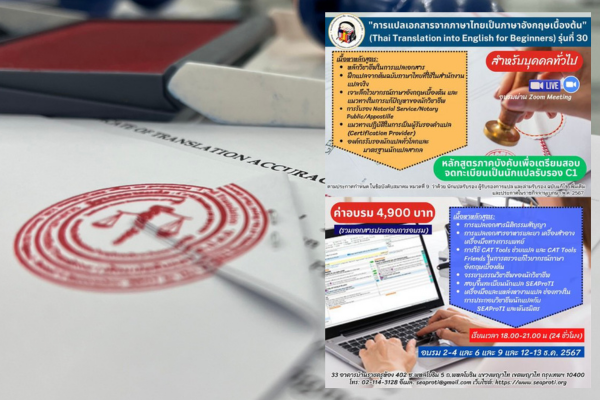Forensic Linguistics: Expertise, Language, and Authority in the Legal Process
Author: Wanitcha Sumanat, president of the Southeast Asian Association of Professional Translators and Interpreters
19 August 2025, Bangkok – The intersection between linguistics and law has grown into a dynamic area of inquiry since the 1970s (Conley & O’Barr, 1998). Forensic linguistics, broadly defined as the application of linguistic knowledge and methods to legal contexts, occupies a contested space in which questions of authority, expertise, and legitimacy are paramount. Two key works exemplify this tension: Janet Cotterill’s Language in the Legal Process (2002/2004) and John Olsson’s Forensic Linguistics: An Introduction to Language, Crime and the Law (2004). Cotterill’s edited volume presents scholarly contributions exploring the discursive practices of the legal system, while Olsson’s textbook provides a practitioner-oriented framework. Taken together, these works illuminate the dilemmas that arise when linguists assert expertise within a domain traditionally governed by legal professionals.
This article examines how authority is constructed, contested, and negotiated in forensic linguistics, focusing on (1) the linguist as advocate versus neutral expert, (2) the competing claims of linguistic and legal expertise, (3) methodological dilemmas in the courtroom, and (4) the broader implications for the discipline’s professional status.
Linguists as Advocates or Neutral Experts
A central tension within forensic linguistics concerns whether linguists should position themselves as neutral analysts or as advocates for marginalized participants. Roger Shuy (2002) emphasizes the dangers of linguists being perceived as partisan, warning that advocacy could diminish their credibility and opportunities to contribute within legal proceedings. From his perspective, linguists must tread carefully to avoid undermining the authority of the judiciary.
Conversely, scholars such as Gail Stygall (2002) and Susan Berk-Seligson (2002) argue that linguists have a moral obligation to support linguistically disadvantaged individuals. Stygall (2002) documents how immigrants face systemic disadvantages in U.S. immigration hearings due to language barriers, while Berk-Seligson (2002) demonstrates the coercive power of poorly delivered Miranda warnings. This position situates linguists as defenders of fairness, aligning with critical perspectives that highlight asymmetry and power imbalances inherent in the legal process.
Authority in Language and Law
Legal professionals traditionally claim authority over language in two ways: as interpreters of legal texts and as practitioners skilled in rhetoric and persuasion. Judges and lawyers routinely determine the meanings of legal terms and invoke the “plain meaning” of everyday words. However, forensic linguists challenge this assumption of competence. They argue that judges may not represent the broader speech community and that empirical methods, such as corpus linguistics or survey-based studies, provide more reliable accounts of meaning (Kaplan, Green, Cunningham, & Levi, 1995).
Yet, resistance from the legal profession is strong. Accepting linguists as experts in ordinary word meaning would effectively transfer interpretive power away from the judiciary. Goddard (1996) explicitly doubts whether linguists should be considered authorities on ordinary language, underscoring the contested boundaries of expertise. This struggle reflects a broader dilemma: whether linguists’ specialized knowledge constitutes unique expertise or whether it merely systematizes what laypeople already understand.
Methodological Dilemmas: Precision vs. Practicality
Courts demand determinate decisions, often binary: guilty or not guilty, legal or illegal. By contrast, linguists typically hedge their analyses, framing conclusions as provisional, data-dependent, or context-specific. This methodological divergence complicates the role of linguistic testimony.
Semantics exemplifies this tension. For instance, in the U.S. Supreme Court case concerning the term enterprise in federal statute, linguists provided empirical evidence suggesting broader interpretations. At the same time, the Court ultimately ruled in line with judicial precedent (Kaplan et al., 1995). Similarly, Langford (2000) attempted to clarify legal terms such as murder and manslaughter by breaking them down into semantic primitives; however, such abstractions risk irrelevance when courts require context-specific determinations.
The “semantic tour guide” metaphor proposed by Solan (1998) offers a middle ground. Rather than claiming superior authority, linguists can guide judges and juries through linguistic complexities, clarifying ambiguities without usurping legal interpretive power. This positioning acknowledges both the limits of linguistic science and the institutional prerogatives of law.
Scientific Status and Forensic Legitimacy
Forensic linguistics has long sought recognition as a “scientific” discipline within the courtroom. Olsson (2004) highlights the need to balance qualitative and quantitative methods while cautioning against exaggerated claims, such as the notion of linguistic “fingerprints.” He argues convincingly that authorial attribution cannot be reduced to statistical measures of sentence length or word frequency, as discourse context and genre play critical roles.
One fruitful avenue has been discourse analysis of confessions and police interviews. Coulthard (2002) demonstrates how supposedly verbatim confessions were reconstructed by police, undermining their reliability. Similarly, suicide notes have been analyzed as a genre with identifiable features that can aid in determining authenticity (Olsson, 2004). However, the question remains whether such analyses meet the evidential threshold of “beyond a reasonable doubt” or merely “balance of probabilities.”
Tensions and Ironies in Forensic Practice
Ironically, while linguists often advocate for plain language in law, their discipline is frequently criticized for jargon and opacity. Forensic linguists thus face the dual responsibility of simplifying their analyses for legal audiences while retaining scholarly rigor (Fraser, 2003). Moreover, much of “core linguistics,” such as formal syntax, has little forensic relevance, necessitating a disciplinary reorientation toward applied and socially engaged research (Harris, 1980).
This disciplinary self-reflection also raises epistemological questions. If linguistic models of politeness, cooperation, or meaning diverge significantly from lay intuitions, their applicability in forensic contexts becomes questionable. As Berk-Seligson (2002) notes, even FBI agents may “independently discover” theories akin to Brown and Levinson’s (1987) politeness framework. Does this undermine the claim to specialized expertise, or does it instead underscore the need for formalized, systematic approaches?
Conclusion
The authority of forensic linguists remains contested. On one hand, they offer critical insights into power asymmetries, discourse practices, and semantic ambiguities that can significantly impact legal outcomes. On the other hand, their expertise often overlaps with, or challenges, the authority of legal professionals who see themselves as the rightful interpreters of language in law.
Forensic linguistics thus occupies an intermediary role. Its practitioners may be most effective not as claimants of exclusive expertise, but as mediators who clarify communication, expose asymmetries, and guide courts through linguistic complexities. By adopting this “tour guide” role, forensic linguists can contribute meaningfully to justice without overstepping institutional boundaries.
References
- Berk-Seligson, S. (2002). The Miranda warnings and linguistic coercion. In J. Cotterill (Ed.), Language in the legal process (pp. 127–143). Palgrave Macmillan.
- Brown, P., & Levinson, S. (1987). Politeness: Some universals in language usage. Cambridge University Press.
- Conley, J., & O’Barr, W. (1998). Just words: Law, language and power. University of Chicago Press.
- Cotterill, J. (Ed.). (2002). Language in the legal process. Palgrave Macmillan.
- Coulthard, M. (2002). Invented and concealed dialogue in written records of verbal evidence produced by the police. In J. Cotterill (Ed.), Language in the legal process (pp. 19–34). Palgrave Macmillan.
- Fraser, H. (2003). Issues in transcription: Factors affecting the reliability of transcripts and evidence in legal cases. Forensic Linguistics, 10(2), 203–226.
- Goddard, C. (1996). Linguistic semantics in the courtroom. Forensic Linguistics, 3(2), 250–272.
- Harris, R. (1980). The language makers. Duckworth.
- Kaplan, J., Green, G., Cunningham, C., & Levi, J. (1995). Bringing linguistics into judicial decision-making: Semantic analysis submitted to the US Supreme Court. Forensic Linguistics, 2(1), 81–98.
- Langford, I. (2000). Forensic semantics: The meaning of murder, manslaughter and homicide. Forensic Linguistics, 7(1), 72–94.
- Olsson, J. (2004). Forensic linguistics: An introduction to language, crime and the law. Continuum.
- Shuy, R. (2002). To testify or not to testify. In J. Cotterill (Ed.), Language in the legal process (pp. 3–18). Palgrave Macmillan.
- Solan, L. (1998). Linguistic experts as semantic tour guides. Forensic Linguistics, 5(2), 87–106.
- Stygall, G. (2002). Textual barriers to United States immigration. In J. Cotterill (Ed.), Language in the legal process (pp. 35–51). Palgrave Macmillan.
About Certified Translators, Translation Certification Providers, and Certified Interpreters of SEAProTI
The Southeast Asian Association of Professional Translators and Interpreters (SEAProTI) has announced the qualifications and requirements for individuals registered as Certified Translators, Translation Certification Providers, and Certified Interpreters of the Association, as stated in Chapter 9 and Chapter 10 of the Royal Gazette of the Secretariat of the Cabinet, Office of the Prime Minister of the Kingdom of Thailand, dated July 25, 2024, Volume 141, Part 66 Ngor, p. 100. Full details can be accessed at: The Royal Thai Government Gazette
SEAProTI is the first professional association in Thailand and Southeast Asia to establish a certification system for Certified Translators, Translation Certification Providers, and Certified Interpreters.
Head Office: Baan Ratchakru Building, Room 402, No. 33, Soi Phahonyothin 5, Phahonyothin Road, Phayathai District, Bangkok 10400 Email: hello@seaproti.com Telephone: (+66) 2-114-3128 (Business hours: Monday–Friday, 9:00 a.m.–5:00 p.m.)
นิติภาษาศาสตร์: ความเชี่ยวชาญ ภาษา และอำนาจในกระบวนการยุติธรรม
ผู้แต่ง วณิชชา สุมานัส นายกสมาคมวิชาชีพนักแปลและล่ามแห่งเอเชียตะวันออกเฉียงใต้
19 สิงหาคม 2568, กรุงเทพมหานคร – ความเชื่อมโยงระหว่างภาษาศาสตร์กับกฎหมายได้พัฒนาขึ้นจนกลายเป็นพื้นที่วิจัยที่มีความเคลื่อนไหวและเข้มข้นมาตั้งแต่ทศวรรษ 1970 (Conley & O’Barr, 1998) โดย “นิติภาษาศาสตร์” หมายถึงการประยุกต์ใช้ความรู้และวิธีการทางภาษาศาสตร์ในบริบททางกฎหมาย ถือเป็นพื้นที่ที่สะท้อนการต่อรองทั้งในมิติ อำนาจ (authority) และ ความเชี่ยวชาญ (expertise) อย่างเด่นชัด ผลงานสำคัญสองเล่มที่สะท้อนมิติความขัดแย้งนี้ ได้แก่ Language in the Legal Process ที่ Janet Cotterill เป็นบรรณาธิการ (2002/2004) ซึ่งเป็นการรวมงานวิชาการเพื่อวิพากษ์และทบทวนวาทกรรมทางกฎหมาย และ Forensic Linguistics: An Introduction to Language, Crime and the Law โดย John Olsson (2004) ซึ่งเน้นการอธิบายแนวปฏิบัติและบทบาทของผู้เชี่ยวชาญในทางปฏิบัติ ทั้งสองเล่มจึงนำเสนอภาพสะท้อนที่ต่างกันระหว่างมุมมองเชิงทฤษฎีกับเชิงภาคสนาม
บทความนี้มุ่งสำรวจว่าอำนาจและความเชี่ยวชาญในนิติภาษาศาสตร์ถูกสร้าง โต้แย้ง และต่อรองอย่างไร โดยเน้นใน 4 ประเด็นหลัก ได้แก่ (1) บทบาทของนักภาษาศาสตร์ ว่าเป็นผู้สนับสนุน (advocate) หรือผู้เชี่ยวชาญที่ต้องดำรงความเป็นกลาง (neutral expert) (2) การแข่งขันระหว่างอำนาจทางภาษาศาสตร์กับอำนาจทางกฎหมาย ที่ปรากฏในพื้นที่ศาลและการสืบสวน (3) ภาวะกลืนไม่เข้าคายไม่ออกเชิงวิธีวิทยา ที่เกิดขึ้นเมื่อหลักวิชาภาษาศาสตร์ต้องเผชิญกับข้อจำกัดของกระบวนการยุติธรรม และ (4) ผลสะท้อนต่อสถานะความชอบธรรมของศาสตร์นิติภาษาศาสตร์ ซึ่งมีผลต่อการยอมรับทั้งในเชิงวิชาการและเชิงปฏิบัติการทางกฎหมาย
นักภาษาศาสตร์: ผู้สนับสนุน หรือ ผู้เชี่ยวชาญที่เป็นกลาง
ประเด็นที่มักมีการถกเถียงกันคือ นักภาษาศาสตร์ควรยืนอยู่ตรงไหนในศาล จะทำหน้าที่เป็น ผู้วิเคราะห์ที่เป็นกลาง ที่ให้ข้อมูลตามหลักวิชาการเท่านั้น หรือจะเป็น ผู้สนับสนุนฝ่ายที่เสียเปรียบ เพื่อช่วยสร้างความยุติธรรมให้สมดุลมากขึ้น
Roger Shuy (2002) เตือนว่า หากนักภาษาศาสตร์เลือกยืนข้างใดข้างหนึ่ง ศาลอาจมองว่าไม่เป็นกลาง และทำให้ความน่าเชื่อถือของพวกเขาในฐานะพยานผู้เชี่ยวชาญลดลง
แต่ในอีกมุมหนึ่ง นักวิชาการอย่าง Gail Stygall (2002) และ Susan Berk-Seligson (2002) เห็นว่านักภาษาศาสตร์มีหน้าที่ทางศีลธรรมที่จะต้องช่วยเหลือผู้ที่เสียเปรียบด้านภาษา เช่น ผู้อพยพที่เข้าสู่กระบวนการศาลตรวจคนเข้าเมือง (Stygall, 2002) หรือผู้ต้องหาที่ไม่ได้รับคำเตือนสิทธิ (Miranda warnings) อย่างครบถ้วนและเข้าใจได้จริง (Berk-Seligson, 2002) มุมมองนี้สะท้อนการใช้วิชาภาษาศาสตร์เพื่อแก้ความเหลื่อมล้ำด้านอำนาจในระบบยุติธรรม
อำนาจในภาษาและกฎหมาย
ในศาล ผู้พิพากษาและทนายความมักถือสิทธิในการตีความภาษากฎหมาย และมักอ้างว่าตนสามารถเข้าถึง “ความหมายโดยตรง” ของถ้อยคำที่ใช้กันทั่วไปได้ แต่แนวคิดจากนิติภาษาศาสตร์กลับตั้งคำถามต่อสมมติฐานนี้ โดยชี้ว่า ผู้พิพากษาไม่อาจเป็นตัวแทนแท้จริงของ “ชุมชนภาษา” ได้เสมอไป และวิธีการเชิงประจักษ์ เช่น การใช้คลังข้อมูลภาษา (corpus) หรือการทำแบบสอบถาม อาจให้หลักฐานที่น่าเชื่อถือกว่าในการอธิบายความหมายของคำ (Kaplan, Green, Cunningham, & Levi, 1995)
ปัญหาคือ ฝ่ายกฎหมายมักไม่ยอมรับ เพราะหากเปิดทางให้นักภาษาศาสตร์มีสิทธิชี้ขาดในความหมายของคำทั่วไป ก็เท่ากับเป็นการโอนอำนาจการตีความออกจากศาลไปยังผู้เชี่ยวชาญภายนอก (Goddard, 1996) ความตึงเครียดนี้จึงไม่ใช่แค่เรื่องภาษา แต่เป็นการปะทะกันระหว่าง อำนาจทางกฎหมาย กับ อำนาจทางวิชาการด้านภาษา
ภาวะกลืนไม่เข้าคายไม่ออกเชิงวิธีวิทยา: ความแม่นยำทางวิชาการ vs. ความเด็ดขาดของศาล
ศาลทำงานอยู่บนตรรกะที่ต้องการคำตอบชัดเจน เช่น “ใช่หรือไม่ใช่” หรือ “ผิดหรือไม่ผิด” แต่ผลการวิเคราะห์ของนิติภาษาศาสตร์กลับมักเป็นลักษณะ มีเงื่อนไขและชั่วคราว (provisional) มากกว่า ซึ่งทำให้เกิดความตึงเครียดระหว่างโลกของวิชาการกับความเป็นจริงในห้องพิจารณาคดี
ตัวอย่างเช่น คดีเกี่ยวกับคำว่า enterprise ในกฎหมายสหรัฐฯ (Kaplan et al., 1995) นักภาษาศาสตร์ใช้วิธีเชิงประจักษ์เสนอความหมายที่กว้างกว่า แต่ศาลกลับเลือกยึดแนวตีความตามคำพิพากษาก่อนหน้าอยู่ดี ขณะที่ Langford (2000) เสนอการใช้ “หน่วยความหมายพื้นฐาน” (semantic primitives) เพื่อตีความคำ เช่น murder หรือ manslaughter แต่แนวทางนี้ก็ยังไม่สอดคล้องกับสิ่งที่ศาลต้องการ เพราะศาลมุ่งหาคำอธิบายที่เจาะจงกับบริบทของแต่ละคดีมากกว่า
Solan (1998) จึงเสนอภาพเปรียบเปรยไว้อย่างน่าสนใจว่า นักภาษาศาสตร์ไม่ควรอ้างสิทธิ์เป็นผู้ชี้ขาดความหมาย แต่ควรทำหน้าที่เหมือน “มัคคุเทศก์ทางความหมาย” (semantic tour guides) ที่ช่วยอธิบายและชี้ทางให้ศาลเห็นทางเลือกในการตีความ มากกว่าจะเป็นผู้ผูกขาดความหมายของถ้อยคำ
สถานะทางวิทยาศาสตร์และความชอบธรรม
Olsson (2004) ชี้ว่านิติภาษาศาสตร์ควรวางตัวอยู่กึ่งกลางระหว่างวิธีการเชิงคุณภาพและเชิงปริมาณ ไม่ควรอ้างผลที่เกินจริง เช่น แนวคิดเรื่อง “ลายนิ้วมือทางภาษา” (linguistic fingerprints) ที่มักถูกวิพากษ์ว่าเป็นเพียงภาพลวงตา มากกว่าจะเป็นหลักฐานเชิงวิทยาศาสตร์ที่ตรวจสอบได้จริง
งานวิจัยด้านวาทกรรมก็สะท้อนประเด็นนี้ชัดเจน เช่น การวิเคราะห์คำให้การหรือบันทึกการสอบสวนของตำรวจ (Coulthard, 2002) ที่เผยให้เห็นความบิดเบือนซึ่งอาจทำให้คำสารภาพไม่ตรงกับข้อเท็จจริง หรือการศึกษา “จดหมายลาตาย” (suicide notes) ที่ใช้ตรวจสอบความน่าเชื่อถือของข้อความ (Olsson, 2004) ผลลัพธ์เหล่านี้แสดงให้เห็นว่านิติภาษาศาสตร์มีศักยภาพในการช่วยตรวจสอบความจริง แต่คำถามสำคัญยังคงอยู่ที่ว่า การวิเคราะห์เหล่านี้มีน้ำหนักเพียงพอที่จะตอบสนองมาตรฐานทางกฎหมายอย่าง “ปราศจากข้อสงสัยอันสมเหตุสมผล” ได้จริงหรือไม่
ความขัดกันและความย้อนแย้ง
นักภาษาศาสตร์มักเรียกร้องให้กฎหมายใช้ ภาษาที่เข้าใจง่ายและตรงไปตรงมา แต่ก็ถูกวิจารณ์กลับมาว่า งานภาษาศาสตร์เองกลับเต็มไปด้วยศัพท์เฉพาะและทฤษฎีซับซ้อนที่คนทั่วไปเข้าไม่ถึง (Fraser, 2003) ยิ่งไปกว่านั้น งานภาษาศาสตร์สายทฤษฎี เช่น วากยสัมพันธ์เชิงทฤษฎี ก็แทบไม่มีประโยชน์ต่อการทำงานเชิงปฏิบัติของนิติภาษาศาสตร์เลย (Harris, 1980)
ยังมีคำถามเชิงปรัชญาความรู้ (epistemology) ที่ท้าทาย เช่น หากทฤษฎีความสุภาพ หรือหลักความร่วมมือของ Grice แตกต่างไปจากความเข้าใจของคนทั่วไปมากเกินไป ผลการวิเคราะห์ที่ได้จากทฤษฎีเหล่านี้จะยังคงมี “ความชอบธรรม” เพียงพอที่จะนำมาใช้ในศาลหรือไม่ (Berk-Seligson, 2002)
บทสรุป
ประเด็นเรื่อง ความชอบธรรมและอำนาจของนักนิติภาษาศาสตร์ ยังคงเป็นที่ถกเถียงอย่างต่อเนื่อง นักภาษาศาสตร์สามารถมีส่วนสำคัญในการส่งเสริมความยุติธรรม ไม่ว่าจะเป็นการเปิดโปงความไม่สมดุลของอำนาจในกระบวนการยุติธรรม หรือการช่วยคลี่คลายความกำกวมของถ้อยคำทางกฎหมาย อย่างไรก็ตาม การอ้างสิทธิ์ว่าเป็นผู้มีอำนาจสูงสุดในการตีความภาษากลับนำไปสู่ความขัดแย้งโดยตรงกับผู้เชี่ยวชาญด้านกฎหมายที่ถือสิทธิในการตีความในศาล
ดังนั้น บทบาทที่เหมาะสมและมีประสิทธิภาพที่สุดของนักนิติภาษาศาสตร์ อาจไม่ใช่การเป็น “ผู้ชี้ขาด” ทางภาษา แต่เป็น ผู้ไกล่เกลี่ยและผู้อธิบาย ที่ช่วยทำให้ศาลและคณะลูกขุนเข้าใจประเด็นทางภาษาอย่างรอบด้าน โดยยังคงเคารพเขตอำนาจของศาลและรักษาความเป็นกลางของตนเอง
อ้างอิง
- Berk-Seligson, S. (2002). The Miranda warnings and linguistic coercion. In J. Cotterill (Ed.), Language in the legal process (pp. 127–143). Palgrave Macmillan.
- Brown, P., & Levinson, S. (1987). Politeness: Some universals in language usage. Cambridge University Press.
- Conley, J., & O’Barr, W. (1998). Just words: Law, language and power. University of Chicago Press.
- Cotterill, J. (Ed.). (2002). Language in the legal process. Palgrave Macmillan.
- Coulthard, M. (2002). Invented and concealed dialogue in written records of verbal evidence produced by the police. In J. Cotterill (Ed.), Language in the legal process (pp. 19–34). Palgrave Macmillan.
- Fraser, H. (2003). Issues in transcription: Factors affecting the reliability of transcripts and evidence in legal cases. Forensic Linguistics, 10(2), 203–226.
- Goddard, C. (1996). Linguistic semantics in the courtroom. Forensic Linguistics, 3(2), 250–272.
- Harris, R. (1980). The language makers. Duckworth.
- Kaplan, J., Green, G., Cunningham, C., & Levi, J. (1995). Bringing linguistics into judicial decision-making: Semantic analysis submitted to the US Supreme Court. Forensic Linguistics, 2(1), 81–98.
- Langford, I. (2000). Forensic semantics: The meaning of murder, manslaughter and homicide. Forensic Linguistics, 7(1), 72–94.
- Olsson, J. (2004). Forensic linguistics: An introduction to language, crime and the law. Continuum.
- Shuy, R. (2002). To testify or not to testify. In J. Cotterill (Ed.), Language in the legal process (pp. 3–18). Palgrave Macmillan.
- Solan, L. (1998). Linguistic experts as semantic tour guides. Forensic Linguistics, 5(2), 87–106.
- Stygall, G. (2002). Textual barriers to United States immigration. In J. Cotterill (Ed.), Language in the legal process (pp. 35–51). Palgrave Macmillan.
เกี่ยวกับนักแปลรับรอง ผู้รับรองการแปล และล่ามรับรองของสมาคมวิชาชีพนักแปลและล่ามแห่งเอเชียตะวันออกเฉียงใต้
สมาคมวิชาชีพนักแปลและล่ามแห่งเอเชียตะวันออกเฉียงใต้ (SEAProTI) ได้ประกาศหลักเกณฑ์และคุณสมบัติผู้ที่ขึ้นทะเบียนเป็น “นักแปลรับรอง (Certified Translators) และผู้รับรองการแปล (Translation Certification Providers) และล่ามรับรอง (Certified Interpreters)” ของสมาคม หมวดที่ 9 และหมวดที่ 10 ในราชกิจจานุเบกษา ของสำนักเลขาธิการคณะรัฐมนตรี ในสำนักนายกรัฐมนตรี แห่งราชอาณาจักรไทย ลงวันที่ 25 ก.ค. 2567 เล่มที่ 141 ตอนที่ 66 ง หน้า 100 อ่านฉบับเต็มได้ที่: นักแปลรับรอง ผู้รับรองการแปล และล่ามรับรอง
*สมาคมวิชาชีพนักแปลและล่ามแห่งเอเชียตะวันออกเฉียงใต้ เป็นสมาคมวิชาชีพแห่งแรกในประเทศไทยและภูมิภาคเอเชียตะวันออกเฉียงใต้ที่มีระบบรับรองนักแปลรับรอง ผู้รับรองการแปล และล่ามรับรอง
สำนักงานใหญ่: อาคารบ้านราชครู เลขที่ 33 ห้อง 402 ซอยพหลโยธิน 5 ถนนพหลโยธิน แขวงพญาไท เขตพญาไท กรุงเทพมหานคร 10400 อีเมล: hello@seaproti.com โทรศัพท์: (+66) 2-114-3128 (เวลาทำการ: วันจันทร์–วันศุกร์ เวลา 9.00–17.00 น.)
